► Bloodhound for sale again
► Funding issues due to Covid
► 1000mph rocket car project hoping to to continue
The Bloodhound landspeed project is up for sale again. After a successful test in South Africa in 2019, in which the car got up to speeds of 628mph, the current owner Ian Warhurst is now stepping away from the project. Warhurst saved the project from total cancellation in 2018, but the Covid-19 pandemic has understandably changed the Bloodhound project’s trajectory. A record-breaking 1000mph run is now penciled in for 2022 – funding allowing.
'It has been a privilege to lead this team of world-class engineers over the past two years. I was spellbound – along with a huge audience around the world – as we tested the car up to 600+ mph in South Africa,’ said Warhurst. ‘When I committed to take the car high speed testing in 2019, I allocated enough funding to achieve this goal on the basis that alternative funding would then allow us to continue to the record attempts.
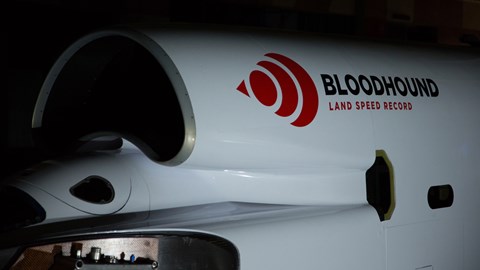
Along with many other things, the global pandemic wrecked this opportunity in 2020 which has left the project unfunded and delayed by a further 12 months.’
If bought again, the next owner of Bloodhound would need to stub up some £8million for the next phase of the project; installing a Nammo monopropellant rocket that’ll power the car to 800mph. Like the previous test, the Nammo test would be carried out at Hakskeen Pan, Northern Cape, SA.
You can read more about Ian’s take over of the project below.
Ian Warhurst buys project
After going into administrationin 2018 - and then being bailed out by Yorkshire entrepreneur Ian Warhurst – the Bloodhound land-speed record attempt relaunched today. Warhurst, the CEO of Grafton LSR has moved headquarters of the Bloodhound to SGS Berkeley Green University Technical College (UTC), and given the car a new look, too. There’s echoes of the Force India, Racing Point story here, isn’t there?

‘Since buying Bloodhound from the administrators last December, the team and I have been overwhelmed by the passion and enthusiasm the public have shown for the project,’ said Warhurst. ‘Over the last decade, an incredible amount of hard graft has been invested in the project and it would be a tragedy to see it go to waste. Starting with a clean slate, it’s my ambition to let Bloodhound off the leash see just how fast this car can go.’
New year, new me
The car will now be called the Bloodhound LSR rather than SSC, and we’re told that the red-and-white livery should soon give way to more sponsors in the future – provided the car stays on track, that is.
‘With Ian providing the cashflow to keep the project on track, Bloodhound LSR is a very different sponsorship proposition to the blue and orange car,’ Grafton LSR’s commercial director Ewen Honeyman said. ‘We’re already having detailed discussions with a number of organisations about exciting new sponsorship possibilities, as well as talking to those involved in the previous phase of the programme.’
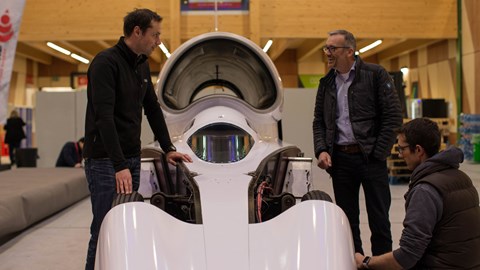
Next up is high-speed testing, and after that, the aim is to break the world land speed record, which currently sits at 763.035mph. Once that’s broken, and engineers assess how the car behaves at transonic and supersonic speed levels, the target will be the car’s theoretical 1000mph top-speed.
What is the current land speed record?
The Bristol-based Bloodhound team are working to surpass today's world record of 763mph.
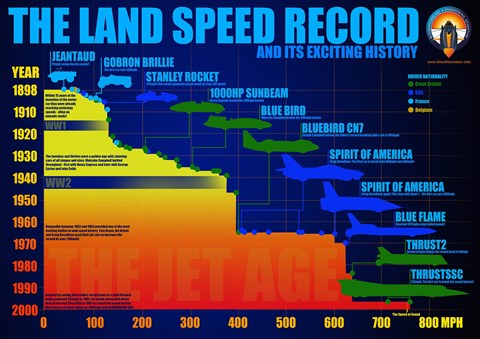
There are still years of testing and development ahead, however; Bloodhound had planned to test on the salt flats of Hakskeen Pan in South Africa in 2019. A special 11-mile high-speed track is being prepared in the Northern Cape for the record attempt.
Why did Bloodhound collapse into administration in autumn 2018?
The organisation appointed Andrew Sheridan and Geoff Rowley, partners at specialist business advisory firm FRP Advisory LLP, as joint administrators on 15 October 2018.
The news followed a successful 200mph straight line test in Cornwall, and came a decade after the project was first revealed in 2007.
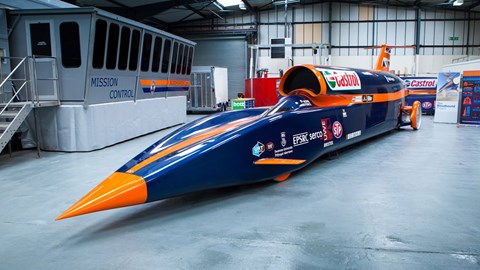
'Whilst not an insignificant amount, the £25 million Bloodhound requires to break the land speed record is a fraction of the cost of, for example, finishing last in a F1 season or running an America's Cup team,' administrator Sheridan said in a statement at the time. 'This is an opportunity for the right investor to leave a lasting legacy. We are already in discussion with a number of potential investors and would encourage any other interested party to contact us without delay.'
They have now found the necessary funds for the project to continue.
Just how fast is the Bloodhound?
The Bloodhound is powered by a Rolls-Royce EJ200 jet engine from a Eurofighter, a cluster of Nammo hybrid rockets and a 550bhp Jaguar V8. At full chat, it's due to cover a mile in 3.6 seconds.
The 135,000bhp motor drives the 7.5-tonne, four-wheeled missile for just long enough to hit the 1000mph barrier, in theory. As for stopping it? An air brake deploys at 800mph, the parachute at 600mph and conventional friction discs come into play at 'just' 200mph.
The team behind the Bloodhound SSC land speed record have already completed a 200mph dry-run - in Cornwall! The plan was then for the supersonic jet car to head to South Africa for summer testing. Airbrakes and new winglets (visible in this rendering by Flock and Siemens) would have been added as the speed ramped up.
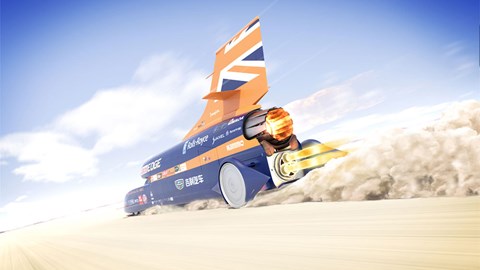
What's it like to drive?
The Bloodhound SSC's cabin is cramped and looks more like the cockpit of a Eurofighter jet than a car. Which means it's business as usual for Andy Green, the RAF pilot who will drive it.
Fighter pilot Green, who received an OBE for his earlier records, said: 'I’ve met graduate engineers who are adamant that our previous record was what inspired their career choice as youngsters: that sort of thing makes all the effort worthwhile.'
Out of time?
The Bloodhound project has been off-schedule from the very beginning; in 2009, it aimed for a 800mph run, followed by a 900mph attempt in 2010 and the full 1000mph in 2011. It’s 2018 now, guys. It's hard not to get wrapped up in the goodwill of this project though - proper, pushing-the-boundary innovation to inspire a generation.
All pictures are by Flock and Siemens